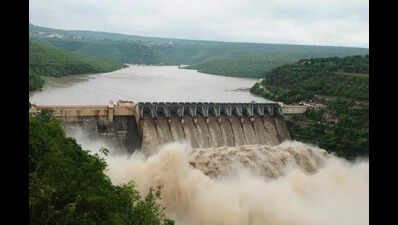Hyderabad: With monsoon-triggered flash floods repeatedly wreaking havoc—claiming lives, damaging public infrastructure, and compromising dam safety—Telangana is spearheading a bold initiative to establish a coordinated, real-time flood management system across states. In a significant move, the Telangana State Committee on Dam Safety (SCDS) has called for seamless data sharing between neighbouring states—Maharashtra, Karnataka, Andhra Pradesh, and Telangana—to proactively manage sudden inflows from upstream reservoirs and safeguard critical irrigation infrastructure.To address the recurring threat of flash floods, the SCDS convened a high-level meeting with irrigation officials from the four states, along with representatives from the Central Water Commission and the National Disaster Response Force. The outcome: A first-of-its-kind Integrated Flood Management System (IFMS) that aims to revolutionise how states monitor, predict, and respond to flood risks in the Krishna and Godavari basins.“The proposed IFMS will provide advance warnings of two to seven days, enabling timely evacuation and flood preparedness,” Telangana’s engineer-in-chief and chairperson of the SCDS, G Anil Kumar, told TOI. It will integrate real-time data from rainfall stations, cloud tracking radars, and dam inflow levels to assess flood risks dynamically.The system also aims to simulate flood scenarios through digital twin technology, helping authorities visualise the impact of potential flood events and identify vulnerable infrastructure, settlements, and transportation networks across the basin.In past instances—such as the 2009 flooding of Kurnool and the near overflow of the Srisailam dam, or the 2022 inundation of Bhadrachalam town due to Godavari floodwaters—poor coordination and delayed data sharing proved disastrous. In one case, the breach of Peddavagu under intense inflows further underscored the urgency for a system like IFMS. According to Anil Kumar, “The IFMS will provide early warnings and actionable insights that can save lives and infrastructure. It’s a long-overdue step towards proactive flood management.”He said that the IFMS will enable real-time monitoring of rainfall, inflows, and flood-prone zones. It will estimate the likelihood of flash floods and heavy rainfall events using radar data and cloud-top temperature analysis, while issuing geo-specific alerts across the basin.To facilitate this, irrigation departments are currently developing new tools and software platforms for real-time data sharing. Institutions such as IIT Hyderabad are being brought in to support the technical development of the flood warning system—not just for Telangana, but also for the city of Hyderabad, which faces periodic urban flooding.“The idea is to track flood flows and water levels in irrigation projects across the basins in real time, and create a digital twin of flood events,” said Anil Kumar. “This will allow us to simulate and visualise potential impacts, helping us identify at-risk infrastructure, agricultural zones, and critical transport links,” he added.During the inter-state meeting, it was agreed that all participating states will share information from real-time rainfall stations within the river basins, as well as key reservoir data, daily water release figures, and standardised application programming interfaces (APIs) from relevant govt agencies. Experts say this collaborative model is expected to set a national precedent for integrated flood management and inter-state water governance.






